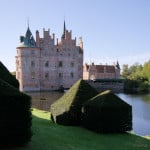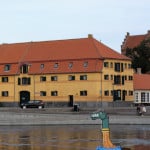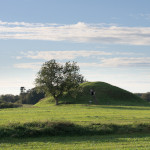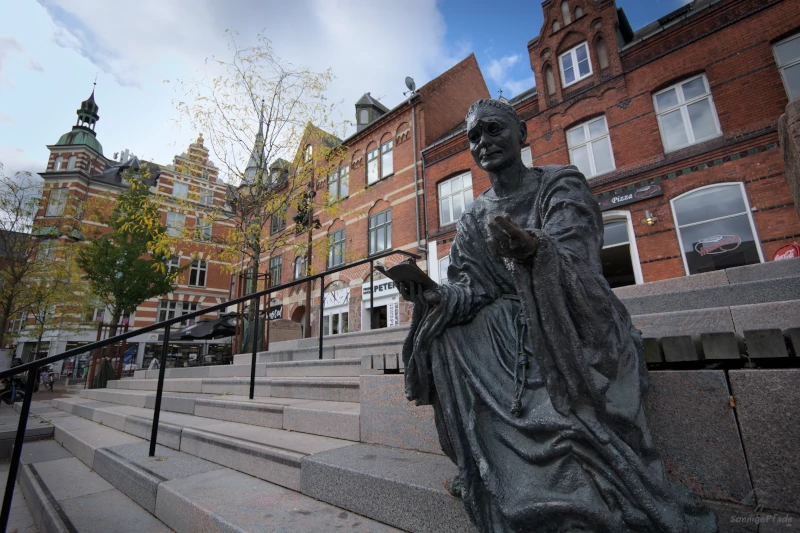
If you are looking for historical places on the Danish island of Funen and want to feel the maritime breeze in your nose, Svendborg is the right place for you. A long history of trade, shipping and the maritime economy has shaped the character of the port town. Svendborg is also the starting point for exploring the islands south of Funen.
For centuries surrounded by sea air – Svendborg
From Langeland to Funen – Svendborg as the gateway to the island
After the round trip on Langeland, I cycled via the „in-between“ island of Tåsinge and the Svendborg Sound to the first town on Funen – Svendborg. Even from the high Svendborg sound bridge I could get the impression of a lively and historic harbor town. Harbour facilities on the banks of the sound, church towers and brightly colored houses on the slopes rising towards the interior of the island and wide green spaces between the buildings promised a pleasant visit to the town after several days in the rural surroundings of Langeland.
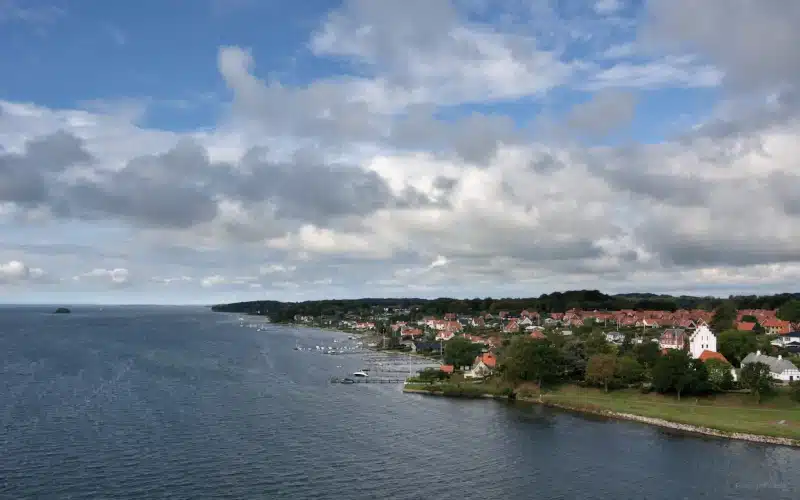
From the bridge, it was a bit of an uphill and, above all, downhill walk. The original districts of Svendborg are closer to the „Sund level“ near the harbor and on the hills around it. I quickly found access to the old town via „Gerritsgade“, where several streets form a pedestrian zone and motor traffic-calmed area.
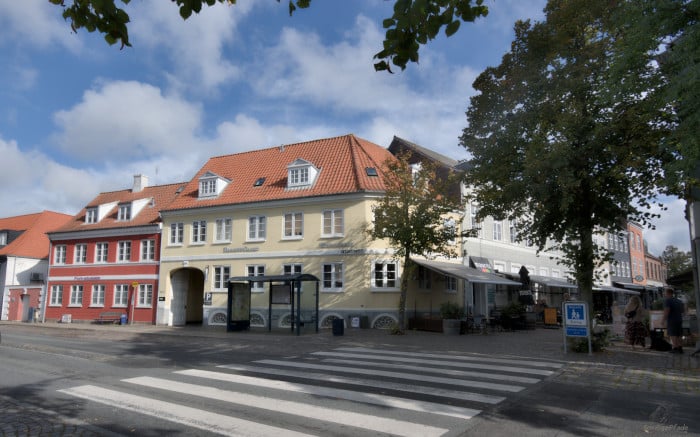
On foot through the old town
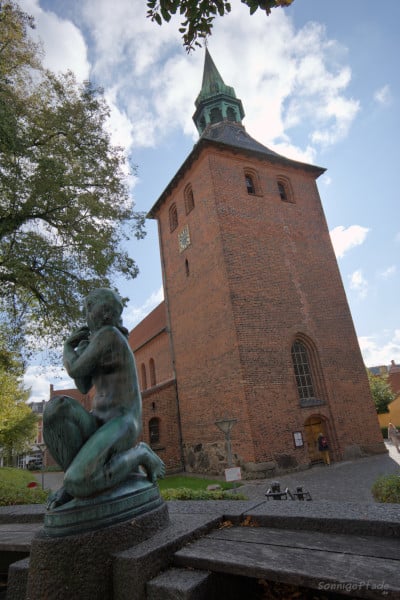
The buildings are varied. Individual modern houses blend relatively inconspicuously into the rows of old town houses. Narrow alleyways alternate with small squares and crossroads, with winding arrangements always providing surprising new insights.
At St. Nicolai Church, one of the two large churches in the old town of Svendborg, a minstrel stands on the forecourt and plays Irish dances on his fiddle. Perhaps not quite fitting for a Danish city – although, as a port city, Svendborg is very cosmopolitan – but I like it and settle down to soak up the impressions of the hustle and bustle to the sound of music.
A friendly place to do some shopping
It’s Saturday morning and the alleyways are bustling with people – mainly for shopping. Because with its many small boutiques, which still offer handcrafted and designer rarities, Svendborg also invites you to take a stroll. Shopping is not really my thing, but the varied displays and the overall flair, which is still reminiscent of the good old days of crafts and small trades, make the walk a pleasure.
At Klosterplads, I am greeted by a monk – not a real one, but made of bronze – who tells me something about the history of the monastery. Unfortunately, almost nothing of it is still visible – the Klosterplads is more like the station forecourt and the monastery has long been demolished and built over. However, a number of traces of monastic life came to light during excavations and so Svendborg wanted to draw attention to this episode in the town’s history with the monk statues on Klosterplads.
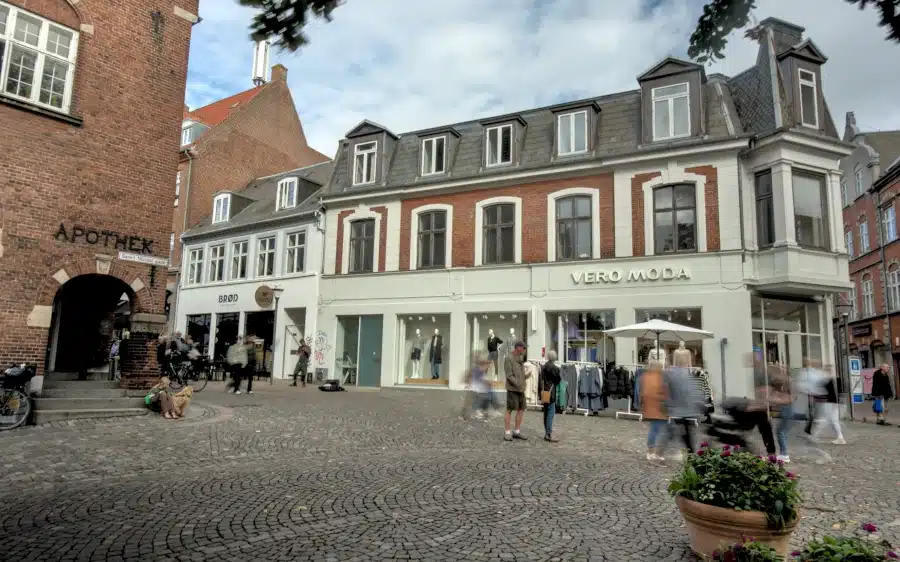
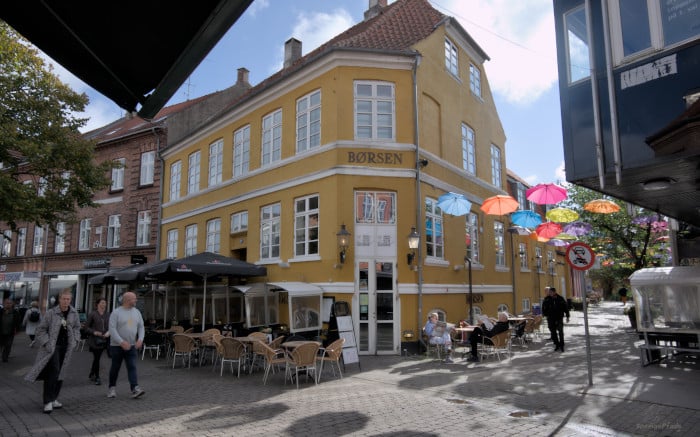
Harbor and ferries to the „archipelago“
It is also not far from the station to the harbor and the harbor island of Frederiksø, the maritime quarter of Svendborg. Not only are old sailing ships moored here, but several ferries also leave from here and connect the large island of Funen with the smaller islands in the „South Funen Archipelago“. Some also refer to it as the „Danish South Sea“. If you want to go „island hopping“, this harbor is the right place for you, and there are also several traditional shipyards on the harbor island of Frederiksø.
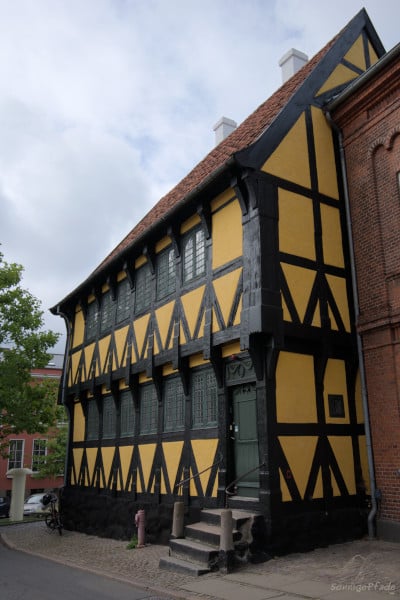
I walk around the large church Vor Frue Kirke and come across a yellow half-timbered house. This is Anne Hvides Gård, an old merchant’s yard that is now part of Svendborg Museum. This yard was built by the noblewoman Anne Hvide from Rødkilde as early as 1560, although several parts of the building had already been demolished by the beginning of the 20th century as its use changed. Anne Hvides Gård has been part of Svendborg Museum since 1915 and is now used for special exhibitions.
Episodes from the history of Svendborg
It is not 100% clear where the name Svendborg comes from. A derivation from Svineburgh – pig castle – is considered likely, but was it about pigs, which populated the surrounding forests as „acorn pigs“ and were served as a delicacy on the spit in the castle canteen, or was it about the marsvin – the „sea pigs“ – porpoises, which still populated the Baltic Sea in large numbers at that time?
Best location on Svendborg Sound
What is certain is that the location of Svineburgh was ideal – a natural bay at the narrowest point of Svendborg Sound formed a sheltered harbor, the island of Funen was and is fertile and both fishing and trade could develop very well. There is nothing left of Svineburgh; it is assumed that it was located on the site of today’s Vor Frue Kirke, around which a town grew that was already the second largest on the island of Funen in the Middle Ages. The first known written reference to Swineburgh was in a deed of gift from King Valdemar II in 1229, who bequeathed the land to his daughter-in-law Eleonora of Portugal. Svendborg received its town charter in 1253.
To the east of the town, another castle – the royal castle Ørkild – provided additional protection against raids. However, this burned down in 1534 and was never rebuilt. The ruins of Ørkild Castle can still be seen today in the Karoline Amalielund pleasure grounds.
Emerging crafts and profitable trade
The herring fishery, trade in products from Fyn’s agriculture and the abundant crafts contributed to Svendborg’s prosperity. The town was characterized by the large market, which was surrounded by the two churches Vor Frue Kirke and Sct. Nicolai Kirke.
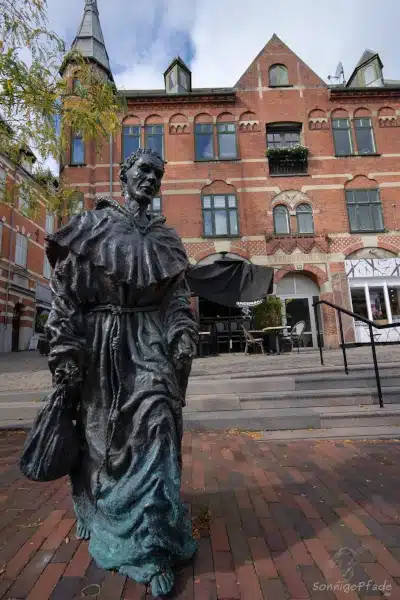
On the eastern edge, facing the harbor, stood an important monastery, which represented the spiritual strength of the town as a rich monastery with a high reputation. Shipyards were also built around the harbor and on the island of Frederiksø, and other businesses such as rope makers, carpenters, blacksmiths etc. supplied components and materials.
The aforementioned Anne Hvides Gård is a kind of mirror image of the development of Svendborg. While the builder Anne Hvide, as a noblewoman, had a summer residence in the countryside and the town house in Svendborg as a winter residence, as was customary among Danish noblemen in the 16th century, the later owners lived and worked mainly in the town.
Well-known owners of the house from 1700 onwards were the Kragh families, who served the community as privy councillors, chamberlains and town councillors. They were followed by Vice-Admiral Jacob Rostgaard, who took part in the Great Northern War with a warship and lived until 1756.
From 1796, the property passed from the nobility to commoners: Christen Børgesen was a skipper and club landlord. Around 1800, town society organized itself into clubs and ‚dramatic societies‘, which from then on met at Børgesen’s house. Widow, son and daughter-in-law continued to run the house for almost 70 years under the name „Madam Børgesen“ as an inn, room landlord and organizer of important celebrations such as fashionable weddings and royal visits.
After the death of Madam Børgesen, the house was used in various ways, including as a technical school and private school. Around 1900, the property was transferred to the city.
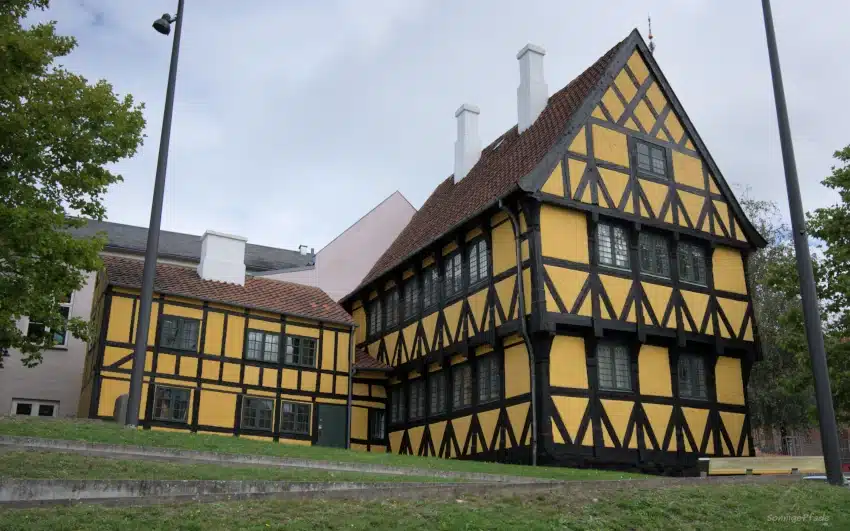
Boost in development in the 19th century
After the Napoleonic Wars in Europe, the town of Svendborg experienced a further upswing. The harbor was expanded and adapted to the larger ships of the time. In 1873, ferry services to islands such as Langeland and Tåsinge began, and ferries to Lübeck and Kiel were also established. A Sydfynske Dampskibsselskab – South Funen Steamship Company was founded and increasingly expanded the sea connections with scheduled services. Transport routes over land improved and a rail link to Svendborg was established in 1876.
Travel tips for Svendborg
How to get there
Next airport with dense international traffic is Copenhagen airport Hans Christian Andersen*. There is full service with trains and busses also rental car service*.
Svendborg can be reached by train from the island’s capital Odense. In Odense there is a connection to the Danish east-west main line from (Malmö) – Copenhagen to Jutland and Schleswig-Holstein.
As the company Fynbussen operates a dense bus network on the island of Funen, it is also possible to travel by public bus from other places such as Nyborg.
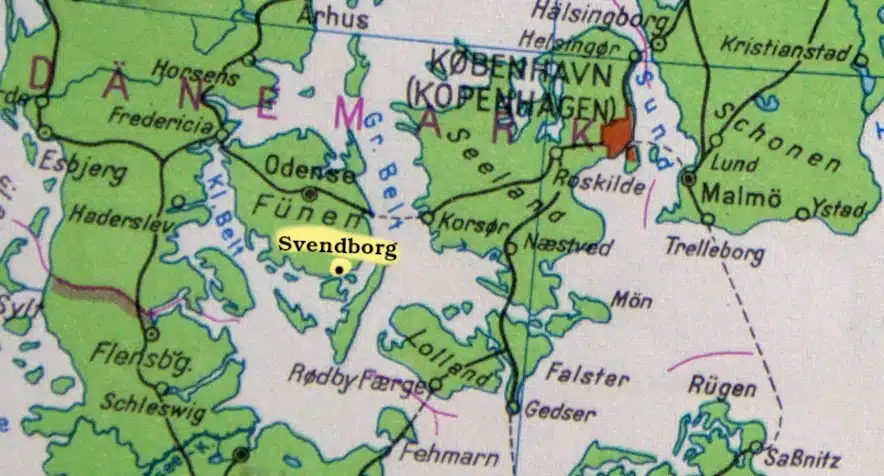
If you prefer an adventurous trip, e.g. by bike, you can travel from the south and east partly by bike over roads and bridges and partly by ferry. There is a ferry from Falster/Lolland to the island of Langeland, from there roads and bridges lead to Svendborg. Island hopping is also possible, e.g. from Rudkøbing (Langeland) by ferry to Aerø and from there to Svendborg.
By car, there are bridge connections to Funen and the mainland via German Schleswig-Holstein and Jutland (east – west motorway E20). From Odense you can use highway 9 to Svendborg. From the east, there is the Öresund Bridge (toll road, motorway E20) from the Danish island of Zealand (with Copenhagen) or the aforementioned connection from Falster/ Lolland by ferry to Langeland and on over the island of Tåsinge with bridges without tolls.

Svendborg weather
You can check the weather in Svendborg sound in the overview opposite.
Is the sun shining for a stroll through the town or is a visit to the museum preferable?
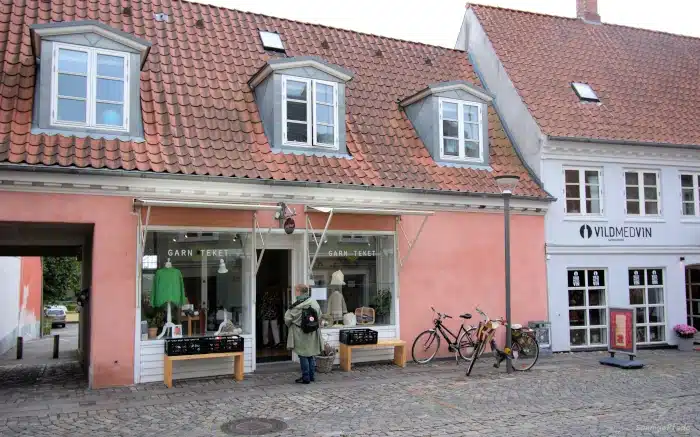
Accommodation in Svendborg
Svendborg has a range of different types of accommodation* – hotels, vacation apartments and small vacation homes, but also glamping, etc. These are scattered around the city and the surrounding area, so that everyone can also see whether they prefer to choose their accommodation directly in the city center or further out in the Fyn countryside. I have tried to group the accommodations from the city center to the wider surroundings of Svendborg, regardless of the type:
Liese’s B&B* offers a range of single and double rooms not far from Svendborg’s city center. The breakfast buffet also offers vegetarian and gluten-free options. Svendborg Vest train station is approx. 1.2 km away. There is ample free parking at the house.
Cozy Apartment* is a simple apartment with balcony and one bedroom close to the center of Svendborg. It can accommodate four people, or two more by using futon beds in the living area. There is no parking, but Svendborg train station is only 900m away.
Rosenhøj Bed and Breakfast* offers double rooms and family rooms in a family atmosphere. The garden with picnic area can also be used for relaxation. The nearest beach is around 1.2 km away and Svendborg town center is within sight. Bicycles can be rented for a fee. Svendborg train station is 1.2 km away. There is free parking at the house.
The ****Stella Maris* is a boutique hotel overlooking the Svendborg Sound, which offers many options for enjoying a stay “close to the sea”: a private bathing area, large lawns for relaxing, a private jetty, in-house restaurant with organic products from the region. The Stella Maris Hotel offers single and double rooms. Bicycles can be rented for a fee. The nearest train station is Svendborg Vest. Free parking is available at the hotel. There is a charging station for electric cars.
Lejlighed Edelweiss* is a vacation home on the island of Tåsinge on the other side of Svendborgsund near the bridge to Svendborg. Two bedrooms with double beds can accommodate four guests, or two more if you use the sofa bed in the living area. A complete, well-equipped kitchen is available. The nearest beach is approx. 1.6 km away. There are parking spaces at the house, and a charging station for electric cars is also available.
More adventures on the island of Funen?
Egeskov Castle – a moated castle with park, gardens and many exhibitions near Svendborg
The small town of Kerteminde – study the water world in the Fjord and Belt Center
Ladby Ship Grave – a very special Viking museum
The Marhoj burial mound – 7m and 5000 years of time travel
Reference to *advertising links
Some of the links in the article are marked with *. If you click on one of these links and book something on the following agency or store page, the sunny trails blog will receive a small commission to cover the technical costs of running it. Nothing will be more expensive for you, as the providers already include the commission in their pricing.

